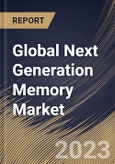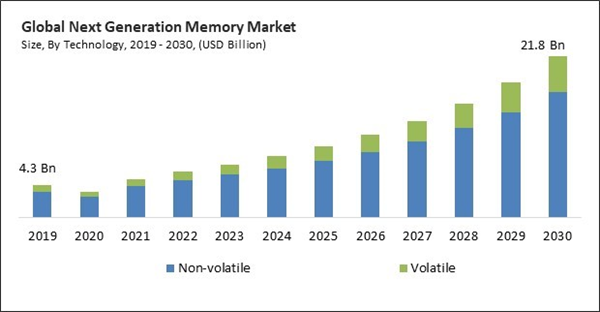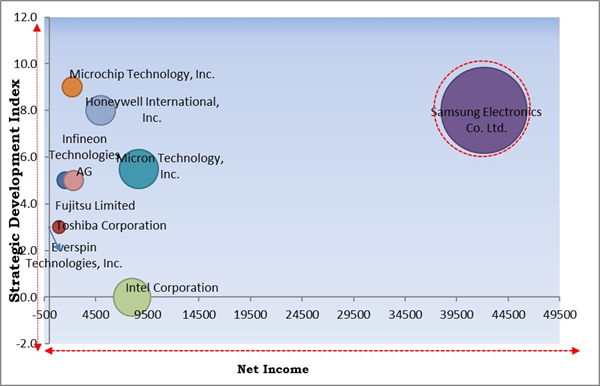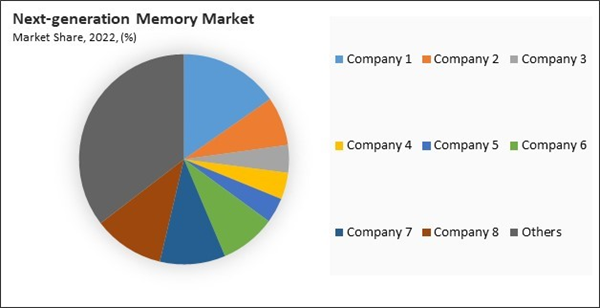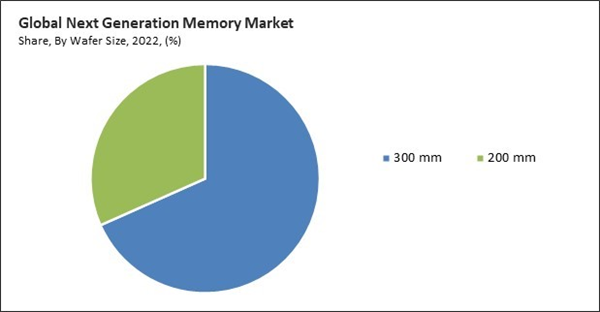The Global Next Generation Memory Market size is expected to reach $21.8 billion by 2030, rising at a market growth of 17.2% CAGR during the forecast period.
Integrating next generation memory technologies brings significant benefits to the forefront of the BFSI industry. These solutions' rapidity and effectiveness are essential for enhancing data analytics and real-time transaction processing capabilities. Therefore, the BFSI sector would generate 1/5th share of the market by 2030. Financial institutions are able to make decisions more quickly and accurately, which is crucial in markets where even milliseconds can have a significant impact. Additionally, data integrity is guaranteed by the non-volatile nature of some next generation memory types, which is crucial for upholding regulatory compliance and preserving trust. Enhancing operational efficiency as well as data security in the BFSI sector is mainly dependent on next generation memory due to the growing volume of financial data and the requirement for strong security measures.
The major strategies followed by the market participants are Product Launches as the key developmental strategy to keep pace with the changing demands of end users. For instance, In October, 2023, Everspin Technologies, Inc. launched the EMxxLX to enhance the high-density STT-MRAM product family. The EMxxLX is an xSPI serial interface for persistent memory. The new product has the features of a clock frequency of 200 MHz and a bandwidth of 400 megabytes per second using eight I/O signals. Additionally, In July, 2023, Samsung Electronics Co. Ltd. launched the Graphics Double Data Rate 7 (GDDR7) DRAM. The new product helps enhance user experiences and provides exceptional graphics performance on game consoles and workstations. Additionally, the new product has applications in AI and automotive vehicles.
The leading players in the market are competing with diverse innovative offerings to remain competitive in the market. The above illustration shows the percentage of revenue shared by some of the leading companies in the market. The leading players of the market are adopting various strategies in order to cater demand coming from the different industries. The key developmental strategies in the market are Product Launches and Product Expansions.
The market research report covers the analysis of key stake holders of the market. Key companies profiled in the report include Samsung Electronics Co. Ltd., Micron Technology, Inc., Fujitsu Limited, Toshiba Corporation, Honeywell International, Inc., Microchip Technology, Inc., Everspin Technologies, Inc., Infineon Technologies AG, Kingston Technology Company, Inc., and Intel Corporation.
Integrating next generation memory technologies brings significant benefits to the forefront of the BFSI industry. These solutions' rapidity and effectiveness are essential for enhancing data analytics and real-time transaction processing capabilities. Therefore, the BFSI sector would generate 1/5th share of the market by 2030. Financial institutions are able to make decisions more quickly and accurately, which is crucial in markets where even milliseconds can have a significant impact. Additionally, data integrity is guaranteed by the non-volatile nature of some next generation memory types, which is crucial for upholding regulatory compliance and preserving trust. Enhancing operational efficiency as well as data security in the BFSI sector is mainly dependent on next generation memory due to the growing volume of financial data and the requirement for strong security measures.
The major strategies followed by the market participants are Product Launches as the key developmental strategy to keep pace with the changing demands of end users. For instance, In October, 2023, Everspin Technologies, Inc. launched the EMxxLX to enhance the high-density STT-MRAM product family. The EMxxLX is an xSPI serial interface for persistent memory. The new product has the features of a clock frequency of 200 MHz and a bandwidth of 400 megabytes per second using eight I/O signals. Additionally, In July, 2023, Samsung Electronics Co. Ltd. launched the Graphics Double Data Rate 7 (GDDR7) DRAM. The new product helps enhance user experiences and provides exceptional graphics performance on game consoles and workstations. Additionally, the new product has applications in AI and automotive vehicles.
Cardinal Matrix
Market Competition Analysis
Based on the Analysis presented in the Cardinal Matrix; Samsung Electronics Co. Ltd. is the forerunner in the Market. Companies such as Micron Technology, Inc., Honeywell International, Inc., Infineon Technologies AG are some of the key innovators in the Market. In October, 2023, Micron Technology, Inc. launched the 16Gb DDR5 memory to enhance its 1β (1-beta) process node technology product portfolio. The new product has the features of 4-phase clocking, clock-sync and high-k CMOS device technology. Additionally, the new product helps to increase performance by 50% and provides an improvement in performance per watt of 33% over the previous generation.Market Growth Factors
Rising demand for high-performance data processing
The surge in demand for high-performance data processing is driven by the growing complexity of data-intensive applications and the need for more efficient memory solutions that can keep pace with the escalating processing requirements. Next Generation Memory technologies, including MRAM, PCM, and others, are uniquely positioned to meet these demands, and their integration into various sectors has ushered in several notable developments. One prominent consequence of this heightened demand is the acceleration of innovation within the Next Generation Memory industry. Next Generation Memory solutions are also crucial for the success of in-memory computing, as they provide the high-speed data access required for this approach. In conclusion, the growing demand for high-performance data processing has been a catalyst for transformative change within the market.Increasing use of emerging technologies
As technology continues to advance and new paradigms such as edge computing, the Internet of Things (IoT), 5G, and artificial intelligence (AI) gain momentum, the demand for memory solutions that can meet the performance and reliability requirements grows. One of the most noteworthy outcomes of this synergy is the convergence of Next Generation Memory technologies with edge computing. Edge computing requires efficient data handling at the network's periphery, close to data sources. Next-generation memory's high-speed data access and low latency make it an ideal companion for edge devices and gateways. As edge computing becomes integral to applications like autonomous vehicles, smart cities, and industrial automation, Next Generation Memory technologies ensure rapid data processing and real-time decision-making at the edge. As AI continues to evolve and shape industries such as healthcare, finance, and autonomous systems, the demand for advanced memory technologies will intensify. Therefore, all of these developments will aid in the expansion of the market.Market Restraining Factors
Significantly high manufacturing costs
The development and production of next-generation memory, such as MRAM and 3D XPoint, involves intricate and specialized processes. These processes often require sophisticated manufacturing facilities, equipment, and a skilled workforce. The initial investment needed to establish such infrastructure can be prohibitively high, making it challenging for smaller players to compete in the market. Moreover, high manufacturing costs directly impact the pricing of Next Generation Memory products. When production expenses are substantial, manufacturers often transfer these costs to consumers, resulting in higher retail prices. In the consumer electronics sector, where price sensitivity is prevalent, the adoption of these technologies may be hampered by their relatively high cost.The leading players in the market are competing with diverse innovative offerings to remain competitive in the market. The above illustration shows the percentage of revenue shared by some of the leading companies in the market. The leading players of the market are adopting various strategies in order to cater demand coming from the different industries. The key developmental strategies in the market are Product Launches and Product Expansions.
Wafer Size Outlook
On the basis of wafer size, the market is divided into 200 nm and 300 nm. The 200 nm segment recorded a substantial revenue share in the market in 2022. The semiconductor industry benefits significantly from the use of 200 mm wafer size. Cost-effectiveness is a major advantage since producing smaller wafers is typically less expensive. This is appealing to companies looking to cut costs and streamline their manufacturing processes without sacrificing the performance and quality of next generation memory components. When smaller production volumes are adequate, 200 mm wafers are especially appealing for specialized applications and niche markets. Their flexibility enables businesses to meet specific customer needs without requiring large-scale production facilities.Technology Outlook
Based on technology, the market is bifurcated into volatile and non-volatile. The non-volatile segment garnered the highest revenue share in the market in 2022. Non-volatile technology offers a number of benefits that are essential for contemporary enterprises. Their capacity to store data even in the absence of power is one of their most notable qualities. Faster boot times and better data integrity are made possible by non-volatile technology, which is essential for applications like financial transactions and crucial data storage where data consistency is vital. Non-volatile memory is necessary for improving energy efficiency, extending mobile device battery life, and lowering data center operating expenses.Vertical Outlook
By vertical, the market is segmented into BFSI, consumer electronics, government, telecommunications, information technology, enterprise storage, automotive & transportation, and others. The enterprise storage region witnessed the largest revenue share in the market in 2022. Next Generation memory technologies, such as MRAM and PCM, provide significantly faster data access times compared to traditional storage solutions like NAND flash. This translates to reduced latency, allowing enterprises to access and process data more quickly. In real-time data analysis, high-frequency trading, and database applications, reduced latency is a game-changer. Many next generation memory types are non-volatile, meaning they retain data even when power is removed. This is advantageous in enterprise storage systems, as it guarantees data integrity and preserves critical information in the event of power failures or outages.Regional Outlook
Region-wise, the market is analyzed across North America, Europe, Asia Pacific, and LAMEA. The Asia Pacific region acquired the maximum revenue share in the market in 2022. Next Generation memory technology is rapidly being adopted in this region due to a number of factors that are in line with the changing business environment in the region. The demand for energy-efficient memory solutions to preserve data in power-off scenarios has increased due to the rapid development of IoT devices throughout Asia Pacific countries. The proliferation of smart devices and the tech-savvy consumer base in the region are the direct causes of this demand. Asia Pacific is a hotspot for the production of semiconductors due to its robust manufacturing ecosystem.The market research report covers the analysis of key stake holders of the market. Key companies profiled in the report include Samsung Electronics Co. Ltd., Micron Technology, Inc., Fujitsu Limited, Toshiba Corporation, Honeywell International, Inc., Microchip Technology, Inc., Everspin Technologies, Inc., Infineon Technologies AG, Kingston Technology Company, Inc., and Intel Corporation.
Strategies deployed in the Market
Partnerships, Collaborations, and Agreements:
- Oct-2023: Micron Technology, Inc. joined hands with Qualcomm Technologies, Inc., a company engaged in developing wireless telecommunication products. Under this collaboration, Micron Technology utilized the Snapdragon 8 Gen 3 mobile platform of Qualcomm Technologies to introduce the 5X (LPDDR5X) memory, which has low power but a double data rate. The new product works at a speed grade of 9.6 gigabits per second (Gbps) and offers the fast performance required for operating generative artificial intelligence (AI).
- Oct-2023: Fujitsu Limited collaborated with TOPPAN Holdings Inc., a Japanese global printing company. Under this collaboration, the analytical technology of TOPPAN Holdings was amalgamated with the data cleansing technology of Fujitsu within the boundaries of a medical record database. Additionally, this collaboration assisted the companies in conducting analysis of medical big data and provided services for enhancing research and development in healthcare.
- Sep-2023: Silicon Storage Technology, Inc., a subsidiary of Microchip Technology, Inc., formed a partnership with GlobalFoundries U.S. Inc., a multinational semiconductor contract manufacturing company. Under this partnership, the SST ESF3 third-generation embedded SuperFlash technology NVM solution was introduced.
- Nov-2022: Infineon Technologies AG came into a partnership with Taiwan Semiconductor Manufacturing Company Limited, a Taiwanese multinational semiconductor contract manufacturing company. Under this partnership, the Resistive RAM (RRAM) Non-Volatile Memory (NVM) technology of TSMC was incorporated into the AURIX microcontrollers (MCU) of Infineon Technologies.
- May-2022: Samsung Electronics Co. Ltd. teamed up with Red Hat, Inc., an American software company. Under this collaboration, open-source software technologies were developed for storage and memory products. Additionally, the collaboration built an ecosystem for establishing a combination of software and hardware.
Product Launches and Product Expansions:
- Oct-2023: Micron Technology, Inc. launched the 16Gb DDR5 memory to enhance its 1β (1-beta) process node technology product portfolio. The new product has the features of 4-phase clocking, clock-sync and high-k CMOS device technology. Additionally, the new product helps to increase performance by 50% and provides an improvement in performance per watt of 33% over the previous generation.
- Oct-2023: Everspin Technologies, Inc. launched the EMxxLX to enhance the high-density STT-MRAM product family. The EMxxLX is an xSPI serial interface for persistent memory. The new product has the features of a clock frequency of 200 MHz and a bandwidth of 400 megabytes per second using eight I/O signals.
- Sep-2023: Toshiba Electronic Devices & Storage Corporation, a subsidiary of Toshiba Corporation, launched the MG10F Series 22TB HDD, a traditional magnetic recording (CMR) HDD device. The MG10F 22TB offers 10% more capability than the previous generation 20TB model of Toshiba. Additionally, the new product has a variety of applications in both traditional datacentre and cloud-scale use cases.
- Jul-2023: Samsung Electronics Co. Ltd. launched the Graphics Double Data Rate 7 (GDDR7) DRAM. The new product helps enhance user experiences and provides exceptional graphics performance on game consoles and workstations. Additionally, the new product has applications in AI and automotive vehicles.
- Apr-2023: Infineon Technologies AG introduced the SEMPER X1 LPDDR Flash, a LPDDR Flash memory assisting next-generation automotive E/E architectures. The SEMPER X1 LPDDR Flash offers safe and reliable real-time code execution. Additionally, the new product offers 8 times better performance than the current NOR Flash memory and 20 times quicker transactions for real-time applications.
- Feb-2023: Fujitsu Limited unveiled the Fujitsu Web3 Acceleration Platform, a platform offering a variety of service APIs based on high-performance computing and blockchain technologies. The new product provides an opportunity for individuals in start-ups and universities to develop several Web3 applications and services. Additionally, the new product connects users to the Computing as a Service Data e-TRUST modules and the Computing as a Service applications of Fujitsu.
- Dec-2022: Samsung Electronics Co., Ltd. introduced the 16-gigabit (Gb) DDR5 DRAM, a technology built using the 12-nanometer (nm)-class process technology. The new product assists in developing the market-wide operations of DDR5 DRAM.
- Aug-2022: Microchip Technology Inc. unveiled the SMC 2000 series of Compute Express Link (CXL)-based Smart Memory Controllers to enhance its serial-attached memory controller product portfolio. The new product helps the CPUs, SoCs and GPUs use CXL interfaces for DDR5 and DDR4 memory. Additionally, the new product offers more bandwidth and memory per core and reduces the Total Cost of Ownership (TCO) in the data centre through optimization of application workloads.
Acquisition and Mergers:
- Mar-2021: Honeywell International, Inc. completed the acquisition of Fiplex Communications, Inc., a worldwide manufacturer of telecommunication products. Through this acquisition, Honeywell enhanced its communications and building connectivity products.
- Dec-2020: Honeywell International, Inc. completed the acquisition of Sparta Systems, a company providing enterprise quality management software (QMS). Through this acquisition, Honeywell solidified its position in the industrial automation and enterprise performance management software markets.
- Oct-2020: Microchip Technology Inc. completed the acquisition of Tekron International Limited, a company producing high-precision atomic and GPS clocks. Through this acquisition, Microchip enhanced its product offering and established its position in the smart energy and industrial markets.
Geographical Expansions:
- May-2023: Micron Technology, Inc. expanded its geographical footprints in Japan through the introduction of ultraviolet (EUV) technology. Through this geographical expansion, sophisticated patterning technology was used in order to develop the 1-gamma (1γ) node, the next generation of DRAM.
Scope of the Study
Market Segments Covered in the Report:
By Technology- Non-volatile
- Magneto-resistive Random-access Memory (MRAM)
- Ferroelectric RAM (FRAM)
- SRAM
- Resistive Random-access Memory (ReRAM)
- Nano RAM
- Others
- Volatile
- 300 mm
- 200 mm
- Enterprise Storage
- Consumer Electronics
- BFSI
- Telecommunications
- Information Technology
- Government
- Automotive & Transportation
- Others
- North America
- US
- Canada
- Mexico
- Rest of North America- Europe
- Germany
- UK
- France
- Russia
- Spain
- Italy
- Rest of Europe- Asia Pacific
- China
- Japan
- India
- South Korea
- Singapore
- Malaysia
- Rest of Asia Pacific- LAMEA
- Brazil
- Argentina
- UAE
- Saudi Arabia
- South Africa
- Nigeria
- Rest of LAMEA
Key Market Players
List of Companies Profiled in the Report:
- Samsung Electronics Co. Ltd.
- Micron Technology, Inc.
- Fujitsu Limited
- Toshiba Corporation
- Honeywell International, Inc.
- Microchip Technology, Inc.
- Everspin Technologies, Inc.
- Infineon Technologies AG
- Kingston Technology Company, Inc.
- Intel Corporation
Unique Offerings
- Exhaustive coverage
- The highest number of Market tables and figures
- Subscription-based model available
- Guaranteed best price
- Assured post sales research support with 10% customization free
Table of Contents
Chapter 1. Market Scope & Methodology
Chapter 2. Market at a Glance
Chapter 3. Market Overview
Chapter 4. Competition Analysis - Global
Chapter 5. Global Next Generation Memory Market, By Technology
Chapter 6. Global Next Generation Memory Market, By Wafer Size
Chapter 7. Global Next Generation Memory Market, By Vertical
Chapter 8. Global Next Generation Memory Market, By Region
Chapter 9. Company Profiles
Companies Mentioned
- Samsung Electronics Co. Ltd.
- Micron Technology, Inc.
- Fujitsu Limited
- Toshiba Corporation
- Honeywell International, Inc.
- Microchip Technology, Inc.
- Everspin Technologies, Inc.
- Infineon Technologies AG
- Kingston Technology Company, Inc.
- Intel Corporation
Methodology

LOADING...


